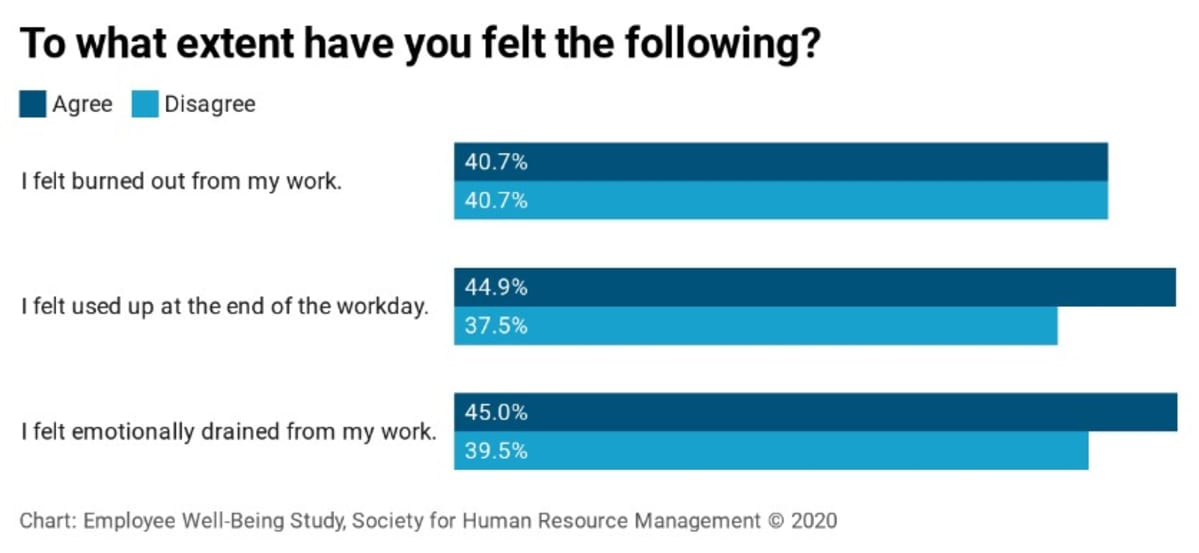Are you feeling emotionally drained, having trouble concentrating or losing interest in activities you once enjoyed? If so, you're not alone.
Between 22 percent and 35 percent of U.S. employees often experience these symptoms of depression as they live through the COVID-19 pandemic, according to new research by the Society for Human Resource Management.
The survey of 1,099 employees found that women, younger workers and people living with at least one person who is a member of a vulnerable population—such as a health care worker or someone with a compromised immune system—were affected the most. Nearly two-thirds of respondents who said they felt like a failure lived with someone who is vulnerable.
"COVID-19 is taking a toll on our minds and emotions in a million little ways," said SHRM President and CEO Johnny C. Taylor, Jr., SHRM-SCP. "Now, more than ever, employers should double down against stigmas and guarantee employees know of the resources, benefits and accommodations available."

Symptoms of depression the survey asked about included difficulty concentrating, feelings of failure or letting the family down, hopelessness, little interest or pleasure in pursuing activities, and feeling tired.
[SHRM members-only toolkit: Managing Employee Assistance Programs]
Work-related concerns left more than 40 percent of employees feeling hopeless, burned out or exhausted as they grapple with lives altered by COVID-19. Among the findings:
- 38 percent of service-based workers report feeling tired versus 31 percent of knowledge-based workers and 26 percent of physical-based industry workers. People working in the service sector were slightly more likely to report little interest in doing things than those in knowledge-based industries (45 percent versus 43 percent).
- 37 percent of workers who do not or cannot telecommute think their pay and benefits have been threatened to a great extent, versus 22 percent of workers who telecommute full time during the pandemic.
- 55 percent report often having little interest or pleasure in doing things since COVID-19 began.
"Unfortunately, many remote workers experience feeling 'out of sight, out of mind' or, even worse, feeling as if their work and dedication are being questioned since they are not physically in the office each day," said Olivia Curtis, wellness specialist for G&A partners, a professional employee organization based in Houston.
"These employees can feel as if they must work twice as hard to prove themselves and get recognized for the work they do," she said. "Employees in this situation often find that the lines between work and home become blurred. They put in more hours than the average office worker, and they experience higher levels of stress due to being 'on' all of the time."
The survey found that 41 percent of respondents felt "burned out."
A generation and gender breakdown showed that:
- 29 percent of Generation Z employees (the oldest are age 23 in 2020) said they often felt depressed or hopeless compared to 22 percent of Millennials (ages 23 to 38 in 2020) and Generation X workers (ages 40 to 55 in 2020) and nearly 16 percent of Baby Boomers (ages 56 to 74 in 2020).
- 51 percent of women reported often feeling depressed or hopeless versus 47 percent of men.
However, more than one-third of all respondents said they have not done anything to cope with their feelings; only 7 percent had contacted a mental health professional.
What Employers Can Do
1. Prioritize mental health in your benefits plan and remind employees of offerings that may be especially helpful.
Starbucks, for example, in April began offering 20 free sessions a year with a mental health therapist or coach to all of its U.S. front-line, hourly workers and eligible family members. A counselor is available in person or through video chat, the global coffee retailer announced March 16. It was planning the benefit before the COVID-19 outbreak, the company said.
Employers can offer health coaching, health and wellness tips, online courses, and health challenges to help employees who are struggling with loneliness, anxiety or depression.
2. Use technology to offer mental health resources.
Employees may not know that their company offers comprehensive mental health resources.
Make them aware of a variety of mental health programs, such as licensed counselors on call, meditation platforms and virtual education for employees to learn coping mechanisms and stress management, advised Nancy Reardon, chief strategy and product officer at Maestro Health. Resources also may include employee assistance programs (EAPs), webinars and online assessments.
3. Stay in touch.
"Your employees should hear from you often, feel supported and cared for frequently," said Henry Albrecht, CEO and founder of Limeade, an employee experience company based in Bellevue, Wash.
There are a variety of ways employers can stay in contact with their employees. Administer small surveys frequently to gauge how they are feeling and identify shifts in attitude so you can adjust communications plans accordingly. Reach out with regular video conferences, daily e-mail updates or a message communication app such as Slack.
"Staying in touch with your employees will help to keep them on task," said Rob Wilson, president of Employco USA, a provider of employer management and HR outsourcing based in Westmont, Ill. "It will also ensure that your employees feel as though they have job security and a role in your company."
4. Offer emotional support.
"Let your employees know that you recognize this is a time of great stress and uncertainty. Offer a list of resources for mental health support or community programs that may help to ease the burden on your staff during this time," Wilson said in a news release.
And just as people check on friends and neighbors to see if they need groceries or other assistance during the crisis, regularly make mental health checks of your employees as well, advised Rick Trimp, president of LivingWorks, a provider of suicide prevention solutions based in Calgary, Canada.
"This isn't something that can be left only to mental health professionals. Family, friends, co-workers, faith leaders—we can and we must help one another through this difficult time."
Suicide is a leading cause of death in the U.S., and rates have been rising in recent decades, according to U.S. Centers for Disease Control and Prevention.
"There are many factors that increase risk for suicide," Trimp said in a news release, "and with issues related to COVID-19—unemployment, social isolation and financial problems—it's difficult for any of us to cope. Those who may have been at risk before are more vulnerable than ever."
Was this resource helpful?




